Yves GARY Hits: 10586
Category: AMERICA
 An English owner
An English ownerAfter her race against Titania, August 28th, 1851, the America was sold by Commodore Stevens, acting for all the owners, for £5,000, to Lord John de Blaquiere, an officer in the Indian army, who cut down her spars five feet, stiffened her with iron braces, which impaired her speed, ...
... and raced her the remainder of the season of 1851 and the next summer with an English crew, losing to the cutters Mosquito and Arrow, July 22d, 1852, in a Queen's cup race, by less than two minutes, and winning, October 12th, 1852, from the Swedish schooner Sverige, the latter quite as much a clipper as the America, and considerably larger.
- The Yacht America (Scientific American MARCH 27,1852) :
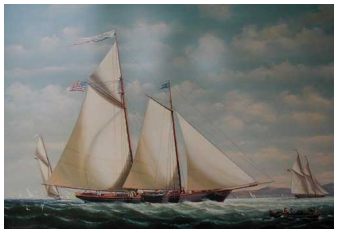 Some time since, an English paper, envious of the fame of the yacht America, started a report that the purchaser of that beautiful craft was disappointed in her, and was anxious to sell her at a reduced price. This report, which was eagerly seized upon by the English papers, was, without doubt, unfounded. It will be seen, by the following extract of a letter, dated Malta, Feb. 6 that the performance of the yacht, on her Mediterranean voyage has been highly satisfactory.
Some time since, an English paper, envious of the fame of the yacht America, started a report that the purchaser of that beautiful craft was disappointed in her, and was anxious to sell her at a reduced price. This report, which was eagerly seized upon by the English papers, was, without doubt, unfounded. It will be seen, by the following extract of a letter, dated Malta, Feb. 6 that the performance of the yacht, on her Mediterranean voyage has been highly satisfactory.
The America, the wonder of the day among yachts, arrived here on the 2nd inst. She came in in beautiful style, after laying-to for four hours in a heavy gale from the N.N.E. Her noble owner, Lord de Blanquiere, is loud in her praises as a vessel of remarkable speed and buoyancy. She will be within four points of the wind and do her fifteen knots an hour with ease. Since leaving England she has had a fair share of heavy weather, and had there been any truth in the prognostics of her detractors, that her masts would be carried away in bad weather, and other similar follies, there was every possible opportunity of their being realized. But the pretty craft nobly did her duty, doing her 14 knots for a whole night, when running with but her jib set, and setting all bad weather at defiance. During her stay she has been visited by numbers of persons. The America will proceed to-morrow to Alexandria."
- The Yacht Race - England Learning. (Scientific American AUGUST 21,1852) :
The Regatta of the Royal Victoria Yacht Club, came off in England on the 23rd of last month. In the contest, the yacht America, which took the prize last year, under the able management of the Commodore at the New York Yacht Club, came in third, two other yachts being before her. This has been made the subject of some rejoicing on the other side of the water, and it has been said boas tingly "the American crack clipper has been compelled to take the third place assigned to her, and the honors of the club have been nobly regained."  This, we say, is not so; the America, in that race, proved herself, as she did before, to be far superior to any yacht in the Royal Club. In the race, by a mistake, she was sailed for some time on a wrong tack, and thus lost considerable time, but even after this, when the other yachts had obtained this advantage, she passed them all, and would have come in first had the breeze not fallen away almost to a calm. The fact admitted in all the accounts of this race, of the America overhauling and passing all the yachts in the squadron, when the breeze was stiff, is proof positive of her superior qualities. The America, by the regulations of the club, was only allowed to carry but one small top sail, while the winning yacht carried large balloon topsails. The name of the winning yacht is" The Arrow," she is an old stager, but during the last winter she was lengthened, and so far as it i could be done, was remodeled after the America. This fact is the most honorable of all to American skill, for it proves incontestably that the advantage and superiority of the America is owing to the higher scientific attainments of the Americans in ship-building. The sails of the English yachts were cut in the American fashion, and everything that possibly could be done, in copying after our celebrated yacht, is an evidence that Uncle John is not too old nor too stubborn to learn from his young relative.
This, we say, is not so; the America, in that race, proved herself, as she did before, to be far superior to any yacht in the Royal Club. In the race, by a mistake, she was sailed for some time on a wrong tack, and thus lost considerable time, but even after this, when the other yachts had obtained this advantage, she passed them all, and would have come in first had the breeze not fallen away almost to a calm. The fact admitted in all the accounts of this race, of the America overhauling and passing all the yachts in the squadron, when the breeze was stiff, is proof positive of her superior qualities. The America, by the regulations of the club, was only allowed to carry but one small top sail, while the winning yacht carried large balloon topsails. The name of the winning yacht is" The Arrow," she is an old stager, but during the last winter she was lengthened, and so far as it i could be done, was remodeled after the America. This fact is the most honorable of all to American skill, for it proves incontestably that the advantage and superiority of the America is owing to the higher scientific attainments of the Americans in ship-building. The sails of the English yachts were cut in the American fashion, and everything that possibly could be done, in copying after our celebrated yacht, is an evidence that Uncle John is not too old nor too stubborn to learn from his young relative.
Lord De Blaquiere, the owner of the America, has written a letter to the London Times, in which he speaks, with enthusiasm respecting her qualities. He has sailed 7,978 miles with her since last November, and when under the most trying circumstances of wind and weather, behaved well. She has astonished many practical seamen in the Malta squadron, and has been distinguished by an almost total absence of repairs owing to the economy of her rig. He believes that her well-judged symmetrical lines, and her simple rig are the causes of her unmatched success, and he hopes that his countrymen will profit by her example.
The Swedes at that time were building the finest schooners in Europe. They adopted the lines of the America, which were more like their own than were the English, and in the spring of 1852 launched at Stockholm their copy of the famous American schooner, which, like the America, was named for the country in which she was built.
|
She had the clipper bow carried to extreme, with a bowsprit but eight feet outboard. She was 280 tons British registry, against the America's 208. Her dimensions were: Length over all 111 feet, beam 25 feet, deck to keelson 11 feet, draft, aft, 12 feet, forward 7 feet 6 inches, mainmast 92 feet 6 inches, foremast 87 feet 6 inches, maintop mast 18 feet, foretop-mast 18 feet, main-boom 58 feet 6 inches, main-gaff 30 feet, fore-gaff 30 feet.
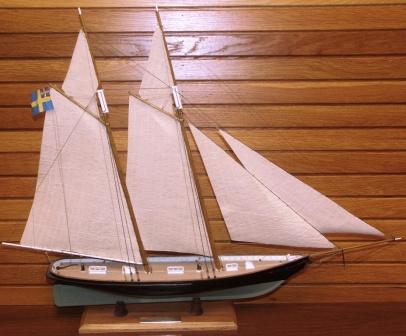
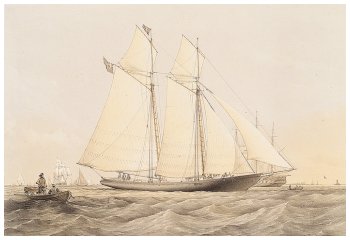 The wind at the start was E. N. E., a smart breeze. Each vessel carried mainsail, fore-and-aft foresail, staysail, maintop mast-staysail and gaff-top-sail. Sverige led the America around the mark vessel by 8 m. 26 s. In rounding the mark she carried away the jaws of her main-gaff, which had to be lashed up and favored in the beat home. At the Nab, the weather being thick, the Swedish vessel over stood the light twenty minutes. She finished 26 m. behind the America. The America proved quicker in stays, and handier in turning to windward than the Swede, while the latter was not well handled, owing partly to confusion among her mixed crew in understanding orders.
The wind at the start was E. N. E., a smart breeze. Each vessel carried mainsail, fore-and-aft foresail, staysail, maintop mast-staysail and gaff-top-sail. Sverige led the America around the mark vessel by 8 m. 26 s. In rounding the mark she carried away the jaws of her main-gaff, which had to be lashed up and favored in the beat home. At the Nab, the weather being thick, the Swedish vessel over stood the light twenty minutes. She finished 26 m. behind the America. The America proved quicker in stays, and handier in turning to windward than the Swede, while the latter was not well handled, owing partly to confusion among her mixed crew in understanding orders.
In this race the cutter Wildfire, forty-seven tons, of the Royal Victoria Yacht Club, beat the America 15 m., 38 s., and the Sverige 7 m. to the outer mark, but did not finish with the racers.
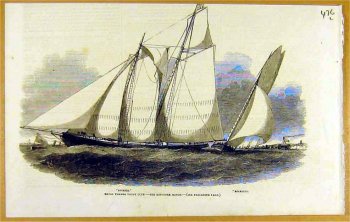 Lord de Blaquiere followed the example of Commodore Stevens in throwing down the gauntlet for the America to all England, but found no one willing to sail him among his countrymen. A challenge posted by him the day before the race with the Sverige, offering to sail any vessel in England — not of American build — for from £500 to £1000, found no takers.
Lord de Blaquiere followed the example of Commodore Stevens in throwing down the gauntlet for the America to all England, but found no one willing to sail him among his countrymen. A challenge posted by him the day before the race with the Sverige, offering to sail any vessel in England — not of American build — for from £500 to £1000, found no takers.
Lord Templeton bought the America from Lord de Blaquiere, and after using her one summer laid her up, in 1854, at Cowes, where she remained until 1859. In that year she was hauled out at Pitcher's yard in Northfleet, near Gravesend, and was found to be dropping apart from dry rot, caused, no doubt, by lack of proper ventilation while laid up. It might be said that the original America ended her career here, if ships did not have a way of taking on new life and of retaining their personality, so to speak, no matter how often they are rebuilt. The owner of the North-fleet yard bought the America at the price of old junk and rebuilt her at his leisure, being a keen man and desirous of preserving the famous model. Americans should count themselves indebted to him. Her frames were replaced with new oak ones, and her planking with teak and elm. She was made stanch and shipshape throughout, as good as new in fact, and started forth again when finished ready for many years of service, for she was not again rebuilt until 1880, in Boston. She left the yard at Northfleet minus the golden eagle and scroll that had adorned her stern, and for years that patriotic emblem graced the parapet of the Eagle Hotel at Kyde, a sign of a publican.
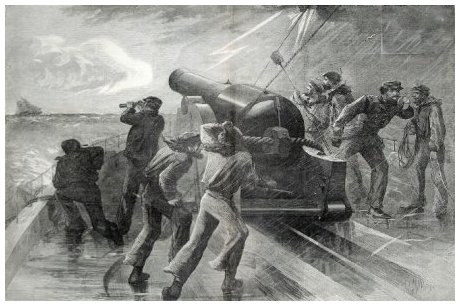 Turbulent comeback in the Stars and Stripes
Turbulent comeback in the Stars and StripesIn 1860 the America was sold to H. E. Decie, Esq., who named her Camilla, cruised with her in the West Indies, and raced her in the summer of that year in England, with indifferent success. She is next heard of on this side of the water, having been bought from her English owner by some person in Savannah, where she arrived in April, 1861, via Porte Grande, Cape de Verde Islands. Her purchaser's name has not been preserved in the custom-house records.
In April, 1862, when the U. S. gunboat Ottawa steamed up the St. John's River on her way to take Jacksonville, her crew noticed the spars of a sunken schooner in the river, and on investigation found the vessel to be the famous America. Commander Thomas H. Stevens, of the Ottawa (afterward rear admiral), a Veteran of two wars, subsequently waived all right to prize money for the capture of the vessel through patriotic motives, on condition that she be turned over to the government for the use of the mid-shipmen at Annapolis.
This was done, and for several years the America, her old name restored, served nominally as a practice-ship for the cadets of the naval academy. Young American sailors felt a big affection for the yacht.
